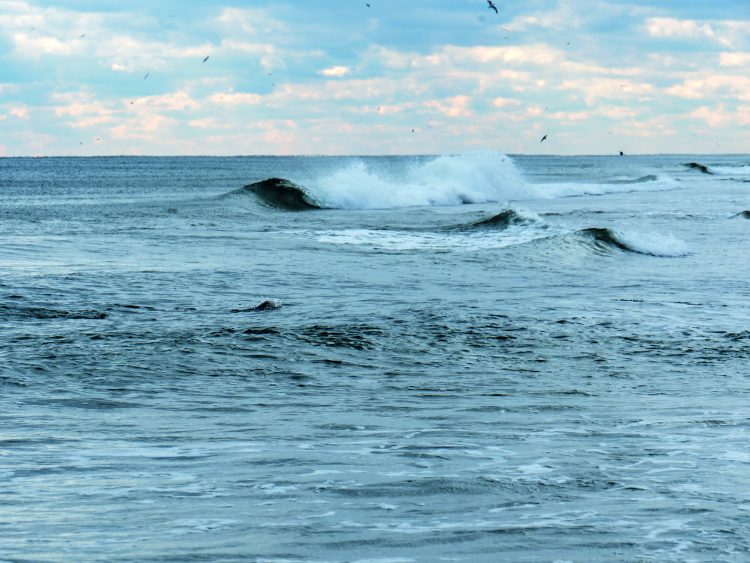5 Foul-Weather Fishing Tips
Get comfortable fishing in uncomfortable weather and you’ll miss fewer fishing days.

August is the start of the hurricane season, a fact that never brings me joy. While we haven’t faced a direct hit from a hurricane in the Northeast in a few years, we still get the big waves and tropical storms it generates. As a kayaker, I lose a few trips every year to these big weather events, which is annoying because August is one of the best fishing months of the year. The fall season is notorious for foul-weather fishing conditions. Even when we don’t get hit by harsh weather, distant storms can still kick up waves that make kayaking difficult. There’s nothing worse than getting to your spot on a perfect weather day only to find that the water is too rough to launch.
Of course, there are alternatives, like staying home. Just kidding! Don’t skip your fishing days. When it is too rough to get out, that often means it is perfect timing for a surf trip. Rough surf often churns up the shoreline and brings bigger stripers in to feed. I’m always amazed at how bass find a lure in chocolate-milk-looking water. There are always plenty of freshwater spots fishable on rough or windy days; smaller water bodies like rivers and ponds have plenty of fish and protected areas.
Kayak fishing in rough weather isn’t for everyone. It takes a while to get comfortable and everyone has their own definition of rough. I’ve been around small boats and rough water my whole life, so my idea of challenging conditions may not be the same as yours. If you have shied away from going out on stirred-up water, there are a few ways you can make yourself more comfortable:
1. Challenge Yourself within Reason
First, go out in appropriate conditions. If you haven’t been out on a rough day, don’t go when the wind is blowing 20 mph and there are whitecaps everywhere. Pick a day that is challenging, but not overwhelming.
2. Stick to Familiar Locations
Stay local and keep it short. Start somewhere you know and are familiar with. Even as an experienced kayaker, I never fish a new spot on a tough weather day. If I know it will be rough, I go somewhere I know well. Don’t plan on going for a long time, either. Paddling or pedaling in rough weather is tiring, and you need to make sure your fitness level matches the conditions.
3. Use The Buddy System
Go with a friend and never kayak alone in adverse conditions, it is always best to fish with a buddy and stay close by. A VHF radio is an effective way to communicate and helpful in an emergency. The most harrowing stories I’ve been told were all from people who didn’t have anyone around to help them when they got into trouble.

4. Scout the Scene
Don’t bring your fishing gear the first time. On your initial trip in the rough stuff, leave your gear at home. Kayaks handle better with a lighter load, and if you flip, you won’t lose everything.
5. Safety First
Wear a PFD. I always wear my PFD when I’m in my kayak, whether it is rough or flat calm. My thinking is that I don’t plan on being in the water, so if I end up there, I want the help of my PFD.
The type of kayak used makes a substantial difference in how it performs in wind and waves. Fishermen tend to prefer short and wide kayaks because they are less tippy, but serious sea kayakers use long and narrow ones because they breeze over big waves and are easy to roll upright if you go over. I don’t know any fishermen interested in rolling their kayaks with their gear on, so unless you have serious kayak skills, you probably don’t want to fish out of a sea kayak. However, those short, fat kayaks can be quite difficult in the rough stuff because they take waves over the bow, and it is difficult to get forward momentum when you’re bouncing through the waves. A longer fishing kayak is a good compromise—a 13- to 15-foot boat will cut across the chop and be much easier to propel through churned-up water.
Whatever kayak you use, practice flipping it on a calm day since you may be surprised at how easy or difficult it is. Some very wide or high-sided kayaks are quite hard to climb back in to. When I practiced, the hardest part was flipping the kayak because I had to figure out where to grab the boat to get it rolling upright. I also had to learn to be patient and let the kayak roll slowly upright. It takes less effort to slowly pull it upright than to flip it quickly. Even a sit-on-top model gets a significant amount of water in the cockpit, so rolling slowly allows it to drain.
Be aware of local conditions. The wind and waves may seem comfortable where you launch, but the place you fish may be another story. Kayakers love to fish current and outflows, and those places often get wind against current—this creates standing waves and very treacherous conditions. Dropping tides can reveal rocks and bars that are hazards in the waves, so these are the areas to avoid when it gets dicey out.
The best way to learn to fish rougher water is to do it incrementally. Start somewhere safe and test yourself to see what your limits are for wind and waves before you go out in big water. You may find that you never want to do it again or that it was easier than you thought. Bad-weather days are often great fishing days, so if you can’t get out in your kayak, break out the surf rods!
Related Content
Understanding Tide and Current
Leave a Reply